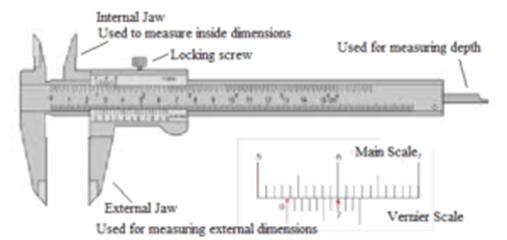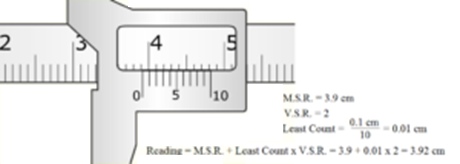Science > Physics > Units and Measurement > Measurement of Length, Area, and Volume Use of Vernier Calipers
Physics is a science of measurement. In science and engineering, we perform experiments. During experiments, we have to take readings. Thus all these experiments require some measurements to be made. During the production of mechanical products, we have to measure the parts so as to find whether the part is made as per the specifications. Thus measurements are necessary for production and quality control. A measurement is a quantitative description of one or more fundamental properties compared to a standard. To measure length is a very important step during the performance of experiments. Measurement can be done directly or indirectly. For direct methods metre scale, vernier calipers, micrometer screw gauges are used. In this article, we shall study the use of Vernier Callipers to measure length, diameter, etc.
Construction:

Vernier calipers is a device is used to measure the internal and external diameter of a tube, the external diameter of a sphere, depth of a vessel, the diameter of thick wires and cylinders.
Typical Vernier calipers consist of a steel strip which is generally marked in centimetre and millimetre along its lower edge this is a fixed scale called the main scale. The end of the main scale is provided with a fixed jaw forming external jaw on the lower side and internal jaw on the upper side. A sliding frame with graduation on the lower side slides over the main scale. This sliding scale is called the Vernier scale. The inside end of a Vernier scale is provided with a fixed jaw forming external jaw on the lower side and internal jaw on the upper side.
Generally, the Vernier scale is provided with N divisions matching with (N – 1) divisions of the main scale.
Least Count of Vernier Scale:
The minimum length that can be measured using the Vernier calipers is called its least count.

Zero Errors of Vernier Calipers:
When the two jaws of Vernier calipers are made to touch each other, then the zero on the main scale should match with a zero on the Vernier scale. However due to wear and tear or manufacturing defect the two zeros usually do not coincide with each other, then the Vernier is said to have zero error. There are two types of zero errors.
Positive zero error:

If on bringing both the jaws together, the zero mark of the Vernier scale is on the right side of a zero mark of the main scale, then the zero error is said to be positive.
To find positive zero error, note the division on the Vernier scale (V.S.R.) coinciding with the division on the main scale. Then the positive error is equal to the product of the number of division on Vernier scale matching with main scale division and the least count of the Vernier. To get correct reading this error is to be subtracted from the overall reading.
Negative zero error:

If on bringing both the jaws together, the zero mark of the Vernier scale is on the left side of a zero mark of the main scale, then the zero error is said to be negative.
To find a negative zero error, note the division on the Vernier scale (V.S.R.) coinciding with the division on the main scale. Subtract this number from a total number of divisions on the Vernier scale to obtain V.S.R. Then the negative error is equal to the product of V.S.R. and the least count of the Vernier. To get correct reading this error is to be added to the overall reading.
Use of Vernier Calipers:

- Hold the object whose dimensions is to be measured in the jaws of the calipers with gentle pressure.
- Note down the main scale reading just before zero of vernier calipers. This is called the main scale reading (M.S.R.)
- Note down the number of vernier scale division (n) which coincides with any division of the main scale. Then vernier scale reading, (V.S.R.) = n X Least Count.
- Add the M.S.R. and the V.S.R. to get reading.
- Subtract the zero error with a proper sign from above reading to get the correct reading.

Uses of Different Parts of Vernier Calipers:
- The outside jaw is used to measure outside dimensions like the length of a rod, the external diameter of the sphere or cylinder.
- The inside jaw is used to measure inside dimensions like the internal diameter of ring or hollow cylinder or pipe
- The strip is used to measure the depth of a beaker or bottle.
- The main scale is used to measure the length of an object correct up to 1 mm.
- Vernier scale is used to measure the length of an object correct up to 0.1 mm
Dial Vernier Calipers (Direct Reading)

Digital Vernier Calipers (Direct Reading)

Problems on Use of Vernier Calipers:
Example 01:
The main scale of a Vernier scale has the least count of 0.5 mm. If 20 divisions of this scale are divided into 25 equal parts of the Vernier scale, what is the least count of the Vernier caliper?
Solution:
1 M.S.D. = 0.5 mm
25 V.S.D. = 20 M.S.D.
Thus, 1 V.S.D. = 20/25 M.S.D. = 0.8 M.S.D. = 0.8 x 0.5 mm = 0.4 mm
Now, Least Count of Vernier Caliper = 1 M.S.D. – 1.V.S.D. = 0.5 mm – 0.4 mm = 0.1 mm
Hence least count of Vernier caliper is 0.1 mm
Example 02:
On Vernier calipers, one centimetre of the main scale is divided into 10 equal parts. If 10 divisions of the Vernier scale coincide with 9 divisions of the main scale, then what will be the least count of the Vernier caliper?
Solution:
1 M.S.D. = cm = 0.1 cm
10 V.S.D. = 9 M.S.D.
Thus, 1 V.S.D = 9/10 M.S.D. = 0.9 M.S.D. = 0.9 x 0.1 cm = 0.09 cm
Now, Least Count of Vernier Caliper = 1 M.S.D. – 1.V.S.D. = 0.1 cm – 0.09 cm = 0.01 cm
Hence least count of Vernier caliper is 0.01 cm
Example 03:
On Vernier calipers, one centimetre of the main scale is divided into 20 equal parts. If the number of divisions on the Vernier scale is 25. Find the least count of the Vernier caliper. In a measurement of the length of an object, the main scale reading lies between 2.35 cm and 2.40 cm. Vernier scale reading is 6. Find the length of the object.
Solution:
On main scale 1 cm is divided into 20 equal parts. Hence 1 M.S.D. = 1/20 cm = 0.05 cm.
Now least count = (1/No. of divisions of Vernier scale) x M.S.D. = (1/25) x 0.05 cm = 0.002 cm.
Reading = Main scale reading + Vernier scale reading x Least Count Reading = 2.35 + 6 x 0.002 = 2.35 + 0.012 = 2.362 cm
Hence the length of the object is 2.362 cm
Example 04:
On Vernier calipers, one centimetre of the main scale is divided into 20 equal parts. If the number of divisions on the Vernier scale is 25. Find the least count of the Vernier caliper. In a measurement of the length of an object, the main scale reading lies between 2.75 cm and 2.80 cm. Vernier scale reading is 9. The zero error is + 0.024 cm. Find the length of the object.
Solution:
On main scale 1 cm is divided into 20 equal parts. Hence 1 M.S.D. = 1/20 cm = 0.05 cm.
Now least count = (1/No. of divisions of vernier scale) x M.S.D. = (1/25) x 0.05 cm = 0.002 cm.
Reading = Main scale reading + Vernier scale reading x Least Count – Zero error Reading
= 2.75 + 9 x 0.002 – (+ 0.024) = 2.75 + 0.018 – 0.024 = 2.744 cm
Hence the length of the object is 2.744 cm
Example 05:
On Vernier calipers, one centimetre of the main scale is divided into 10 equal parts. If the number of divisions on the Vernier scale are 10. Find the least count of the Vernier caliper. In a measurement of the length of an object, the main scale reading lies between 5.6 cm and 5.7 cm. Vernier scale reading is 4. The zero error is – 0.02 cm. Find the length of the object.
Solution:
On main scale 1 cm is divided into 10 equal parts. Hence 1 M.S.D. = 1/10 cm = 0.1 cm.
Now least count = (1/No. of divisions of vernier scale) x M.S.D. = (1/10) x 0.1 cm = 0.01 cm.
Reading = Main scale reading + Vernier scale reading Least Count – Zero error Reading
= 5.6 + 4 x 0.01 – (- 0.02) = 5.6 + 0.04 +0.02 = 5.66 cm
Hence the length of the object is 5.66 cm
For More Topics in Measurement of Length, Area, and Volume Click Here

One reply on “Use of Vernier Calipers”
This is really a nice summary ;anyone can understand quickly.This really helped me to improve.